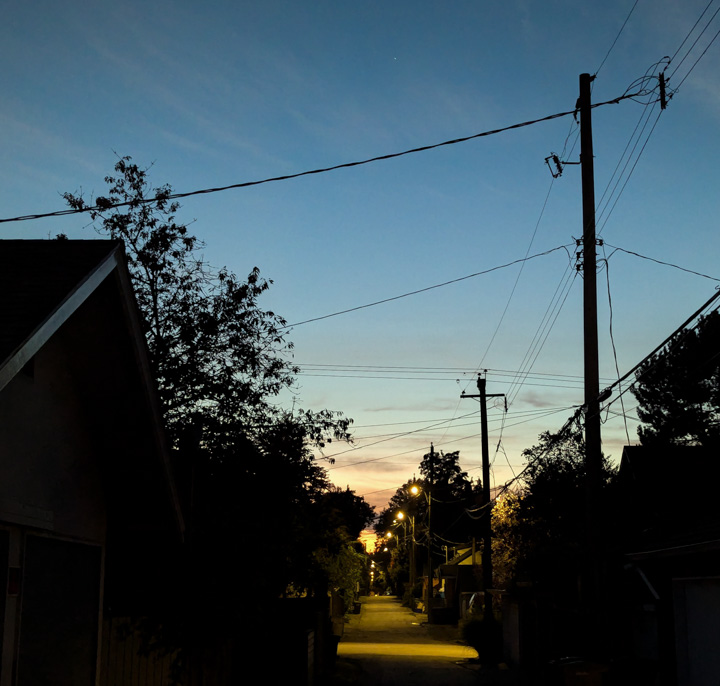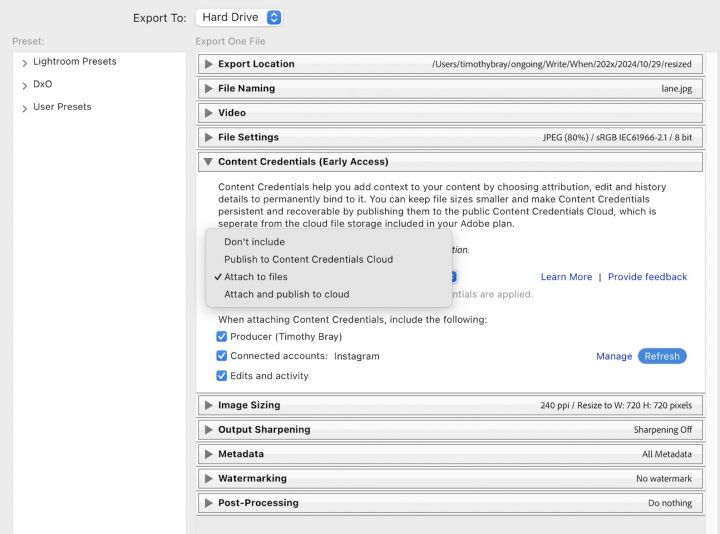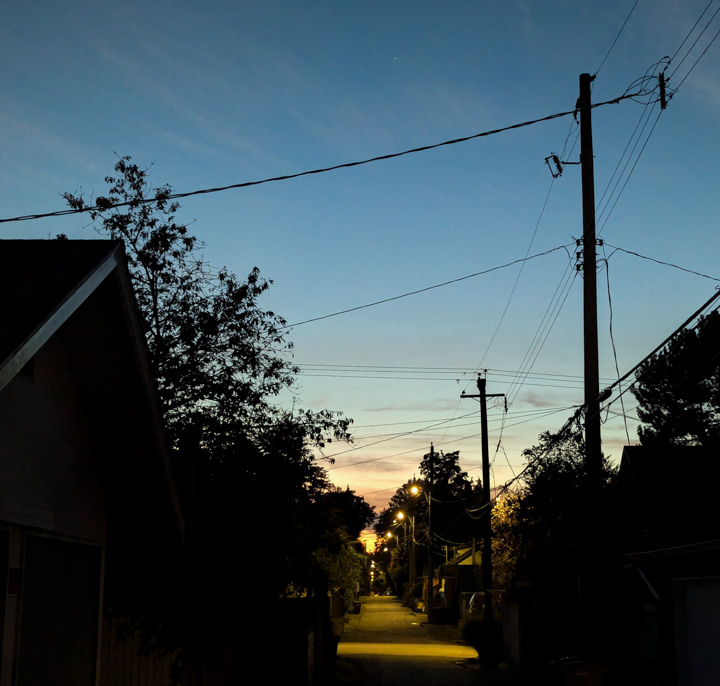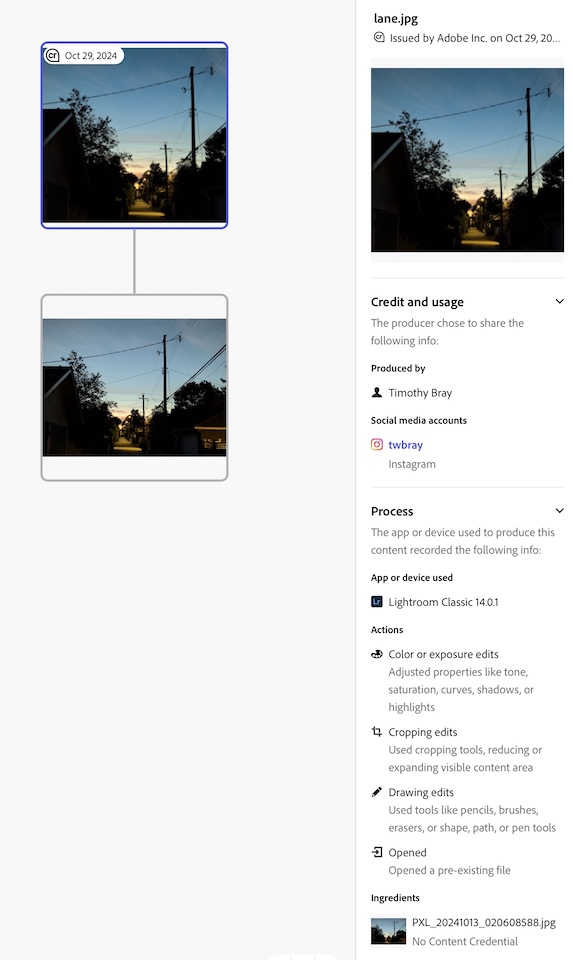
I took a picture looking down a lane at sunset and liked the way it came out, so I prettied it up a bit in Lightroom to post on Mastodon. When I exported the JPG, I was suddenly in the world of C2PA, so here’s a report on progress and problems. This article is a bit on the geeky side but I think the most interesting bits concern policy issues. So if you’re interested in online truth and disinformation you might want to read on.
If you don’t know what “C2PA” is, I immodestly think my introduction is a decent place to start. Tl;dr: Verifiable provenance for online media files. If for some reason you think “That can’t possibly work”, please go read my intro.
Here’s the Lightroom photo-export dialog that got my attention:
There’s interesting stuff in that dialog. First, it’s “Early Access”, and I hope that means not fixed in stone, because there are issues (not just the obvious typo); I’ll get to them.
Where’s the data? · There’s a choice of where to put the C2PA data (if you want any): Right there in the image, in “Content Credentials Cloud” (let’s say CCC), or both. That CCC stuff is (weakly) explained here — scroll down to “How are Content Credentials stored and recovered?” I think storing the C2PA data in an online service rather than in the photo is an OK idea — doesn’t weaken the verifiability story I think, although as a blogger I might be happier if it were stored here on the blog? This whole area is work in progress.
What surprised me on that Adobe CCC page was the suggestion that you might be able to recover the C2PA data about a picture from which it had been stripped. Obviously this could be a very bad thing if you’d stripped that data for a good reason.
I’m wondering what other fields you could search on in CCC… could you find pictures if you knew what camera they were shot with, on some particular date? Lots of complicated policy issues here.
Also there’s the matter of size: The raw JPG of the picture is 346K, which balloons to 582K with the C2PA. Which doesn’t bother me in the slightest, but if I were serving millions of pictures per day it would.
Who provided the picture? · I maintain that the single most important thing about C2PA isn’t recording what camera or software was used, it’s identifying who the source of the picture is. Because, living online, your decisions on what to believe are going to rely heavily on who to believe. So what does Lightroom’s C2PA feature offer?
First, it asserts that the picture is by “Timothy Bray”; notice that that value is hardwired and I can’t change it. Second, that there’s a connected account at Instagram. In the C2PA, these assertions are signed with an Adobe-issued certificate, which is to say Adobe thinks you should believe them.
Let’s look at both. Adobe is willing to sign off on the author being “Timothy Bray”, but they know a lot more about me; my email, and that I’ve been a paying customer for years. Acknowledging my name is nice but it’d be really unsurprising if they have another Tim Bray among their millions of customers. And suppose my name was Jane Smith or some such.
It’d be well within Adobe’s powers to become an identity provider and give me a permanent ID like “https://id.adobe.com/timbray0351”, and include that in the C2PA. Which would be way more useful to establish provenance, but then Adobe Legal would want to take a very close look at what they’d be getting themselves into.
But maybe that’s OK, because it’s offering to include my “Connected” Instagram account, https://www.instagram.com/twbray. By “connected” they mean that Lightroom went through an OAuth dance with Meta and I had to authorize either giving Insta access to Adobe or Adobe to Insta, I forget which. Anyhow, that OAuth stuff works. Adobe really truly knows that I control that Insta ID and they can cheerfully sign off on that fact.
They also offered me the choice of Behance, Xitter, and LinkedIn.
I’ll be honest: This excites me. If I really want to establish confidence that this picture is from me, I can’t think of a better way than a verifiable link to a bunch of my online presences, saying “this is from that guy you also know as…” Obviously, I want them to add my blog and Mastodon and Bluesky and Google and Apple and my employer and my alma mater and my bank, and then let me choose, per picture, which (if any) of those I want to include in the C2PA. This is very powerful stuff on the provenance front.
Note that the C2PA doesn’t include anything about what kind of device I took the picture on (a Pixel), nor when I took it, but that’d be reasonably straightforward for Google’s camera app to include. I don’t think that information is as important as provenance but I can imagine applications where it’d be interesting.
What did they do to the picture? · The final choice in that export dialog is whether I want to disclose what I did in Lightroom: “Edits and Activity”. Once again, that’s not as interesting as the provenance, but it might be if we wanted to flag AI intervention. And there are already problems in how that data is used; more below.
Anyhow, here’s the picture; I don’t know if it pleases your eye but it does mine.
Now, that image just above has been through the ongoing publishing system, which doesn’t know about C2PA, but if you click and enlarge it, the version you get is straight outta Lightroom and retains the C2PA data.
If you want to be sure, install
c2patool, and apply it to lane.jpg.
Too lazy? No problem, because here’s the JSON output (with the --detailed option).
If you’re geeky at all and care about this stuff, you might want to poke around in there.
Another thing you might want to do is download lane.jpg and feed it to the Adobe Content Authenticity Inspect page. Here’s what you get:
This is obviously a service that’s early in its life and undoubtedly will get more polish. But still, interesting and useful.
Not perfect · In case it’s not obvious, I’m pretty bullish on C2PA and think it provides us useful weapons against online disinformation and to support trust frameworks. So, yay Adobe, congrats on an excellent start! But, things bother me:
I couldn’t figure out how to use the open-source “c2patool” to actually verify the signatures, even though I can on c2patool’s sample image. I suspect that this is at least partly c2patool’s fault, and if that I understood certificate lists better, I could have figured out an incantation to make the software work.
But still, if you’re shipping a standards-based product, you should really ensure that it works out of the box with the leading (only?) open-source tool, or at least provide instructions.
Adobe’s Inspector is also available as a Chrome extension. I’m assuming they’ll support more browsers going forward. Assuming a browser extension is actually useful, which isn’t obvious.
The Inspector’s description of what I did in Lightroom doesn’t correspond very well to what the C2PA data says. What I actually did, per the C2PA, was (look for “actions” in the JSON):
Opened an existing file named “PXL_20241013_020608588.jpg”.
Reduced the exposure by -15.
Generated a (non-AI) mask, a linear gradient from the top of the picture down.
In the mask, moved the “Shadows” slider to -16.
Cropped and straightened the picture (the C2PA doesn’t say how much).
Changed the masking again; not sure why this is here because I didn’t do any more editing.
The Inspector output tries to express all this in vague nontechnical English, which loses a lot of information and in one case is just wrong: “Drawing edits: Used tools like pencils, brushes, erasers, or shape, path, or pen tools”. I think that in 2024, anyone who cares enough to look at this stuff knows about cropping and exposure adjustments and so on, they’re ubiquitous everywhere photos are shared.
If I generate C2PA data in an Adobe product, and if I’ve used any of their AI-based tools that either create or remove content, that absolutely should be recorded in the C2PA. Not as an optional extra.
I really, really want Adobe to build a flexible identity framework so you can link to identities via DNS records or
.well-knownfiles or OpenID Connect flows, so that I get to pick which identities are included with the C2PA. This, I think, would be huge.This is not an Adobe problem, but it bothers me that I can’t upload this photo to any of my social-media accounts without losing the C2PA data. It would be a massive win if all the social-media platforms, when you uploaded a photo with C2PA data, preserved it and added more, saying who initially uploaded it. If you know anyone who writes social-media software, please tell them.
Once again, this is progress! Life online with media provenance will be better than the before times.
如有侵权请联系:admin#unsafe.sh


